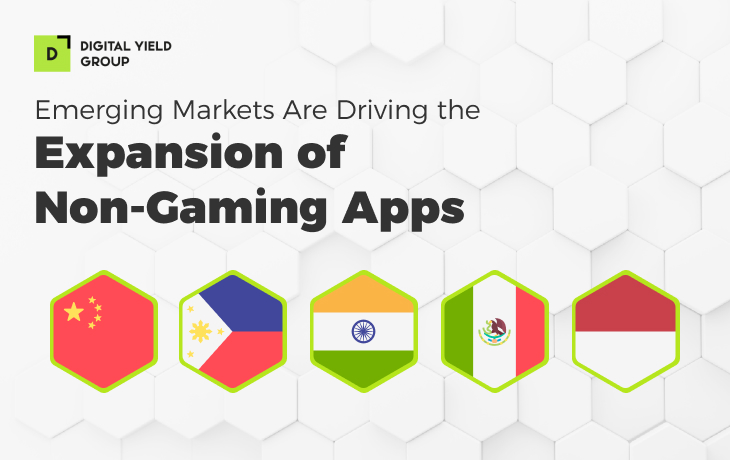The Great Mobile Shift: Why Non-Gaming App Revenue is Overtaking Gaming

The mobile app economy is at an undeniable turning point. For years, mobile games have been the main source of in-app purchase (IAP) revenue, setting the tone for how the industry grows and where money is invested. But that’s starting to change—and the impact will be felt across the entire ecosystem.
Non-gaming apps, which made up just 26% of global app revenue in 2019, now account for 37% of what users spend on app stores. That growth is speeding up: in 2024, non-gaming apps grew by 8%, while spending on user acquisition for games dropped by 7%. Sensor Tower reports that non-gaming app revenue is “on track to overtake game revenue before the end of this year”, an enormous shift from 2020, when people spent 2.5 times more on games than on any other kind of app.
This isn’t just a trend or a blip. It’s a real change in how apps make money, and where the biggest opportunities are. Understanding this pivot is not merely academic, for app developers, publishers, and marketers, being an active part in this shift is key to making smart decisions for future success.
The Historical Trajectory
When COVID-19 hit, mobile usage exploded. Gaming app installs jumped by 45% in 2020 compared to the year before, and spending on non-gaming apps rose nearly 50% after mid-March 2020. At its peak, gaming IAP revenue in May 2020 was 25% higher than it was in February.
But that initial surge didn’t last across the board. While game installs started to drop after mid-April, non-gaming app revenue stayed high. These apps became part of people’s daily routines, and that staying power helped set the stage for what we’re seeing now. Since then, the gap has only widened. Non-gaming apps are setting the pace for where the mobile economy is headed next.
Unpacking the Growth
The shift is clear in the latest numbers. In 2024, non-gaming apps saw their IAP revenue grow by nearly 20%, while their IAA revenue jumped 26% YoY. Meanwhile, gaming IAP revenue stayed flat, or even dipped slightly, though gaming IAA did grow by 7%. In other words, most of the market’s growth is now coming from non-gaming apps.
On the platform side, iOS remains far ahead in monetization. Non-gaming subscription apps on iOS have an ARPU of $8.39, compared to just $1.54 on Android — showing that iOS users tend to spend more. That said, Android is performing well with hybrid monetization models. For example, mid-core games using both IAP and ads reached a 146% ROAS by Day 90, versus 93% for IAP-only models.
Among non-gaming categories, Generative AI and Lifestyle apps are leading the charge. In 2024, GenAI apps grew by 200%, and Lifestyle apps by 68%. GenAI apps alone brought in nearly $1.3 billion in IAP revenue globally, a YoY jump of almost 180%! The top-performing app in this space is ChatGPT, which saw nearly 50% growth in subscriptions in Q1 2025.
Meanwhile, entertainment continues to be a major force, with short video and streaming apps driving strong IAP performance. A big part of this growth comes from short drama apps like DramaBox, ReelShort, and Dramawave. In fact, four of the top 10 apps by quarter-over-quarter IAP growth in Q1 2025 were short drama platforms. Their success highlights the demand for engaging, bite-sized video content and effective global expansion strategies.
Regional Hotbeds of App Monetization
As the mobile app economy evolves, regional trends are becoming just as important as global ones—offering clues about where users are spending and why.
The U.S. holds its spot as the top mobile market for in-app purchases, pulling in an impressive $13.65 billion in Q1 2025. While gaming app revenue dipped 10% after its peak, it’s still well above pre-pandemic levels—showing lasting strength even after the initial surge.
Meanwhile, Japan delivered a surprise comeback, recording the fastest IAP growth among major markets with an 18% year-over-year jump. That’s a notable reversal after years of decline between 2021 and 2024, mostly driven by a shrinking gaming sector.
Mainland China added over $2 billion in new IAP revenue compared to last year, accounting for about half of global growth in Q1 2025. China also stands out as iOS’s second-largest market, an important detail since iOS users consistently spend more on apps worldwide.
In South Korea, the gaming market is also shifting. While RPGs saw a steep 29% drop in IAP revenue, other genres picked up the slack: strategy games grew 10% year-over-year, and puzzle games rose 16%. This shift points to changing user preferences and a rebalancing of where spending is going.
Navigating the New Frontier
As user behavior evolves, so do monetization strategies, especially outside the gaming world. More non-gaming apps are moving beyond just subscriptions and turning to in-app advertising to diversify their revenue streams. That shift matters: over 90% of users prefer free app experiences, and hybrid models are proving to be the most effective. While 82% of non-gaming apps still rely on subscriptions, adding IAA is becoming essential. One example is Audiomack, which saw a 50% increase in Revenue Per Request (RPR) in tier 1 markets after adding app open ads.
AI is also playing a growing role in monetization and marketing. Tools like Claude.ai and Canva are transforming how content is created, while companies like HubSpot and Airbnb are using AI to improve how that content reaches users. AI is becoming a core technology for hyper-personalization, helping apps boost conversion rates and customer lifetime value. AppsFlyer notes that AI in marketing is moving beyond buzzwords, integrating into content production, measurement, and optimization.
Strategic User Acquisition for Non-Gaming Apps
As competition grows and user behavior shifts, app marketers are rethinking what successful user acquisition really means. It’s no longer just about getting installs, but rather about finding users who stick around, engage meaningfully, and generate long-term value. One way to get there is by broadening ad spend beyond social channels. Consumer app advertisers who diversify to independent platforms have seen Day 30 return on ad spend (ROAS) jump by 116%.
AI and data analytics play a big role too, helping teams predict user behavior and target segments with higher potential for retention and revenue. At the same time, new risk-sharing models, like CPA, revenue share, and hybrid deals are common. These performance-based partnerships help reduce upfront costs for publishers, align incentives across teams, and shift the focus to what really matters: what users do after the install.
Summary
The changes reshaping the mobile app economy aren’t just trends, they reflect a deeper shift in how value is created, measured, and sustained. At DYG we support app teams in making sense of this complexity, helping you adjust strategies with clarity and confidence. From rethinking monetization models to refining user acquisition through data and AI, we focus on what drives long-term impact. In a market defined by rapid change, having the right partner to navigate that shift makes all the difference.

